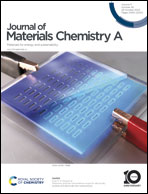Multicore–shell iron fluoride@carbon microspheres as a long-life cathode for high-energy lithium batteries†
Abstract
The study of multi-electron conversion cathodes is an important direction for developing next-generation rechargeable batteries. Iron fluoride (FeF3), in particular, has a high theoretical specific capacity (712 mA h g−1) and a low cost for Li storage. However, the FeF3 material suffers from poor conductivity, volume change and active material dissolution, resulting in voltage hysteresis and poor cycling and rate performance during electrochemical reactions. Here novel multicore–shell FeF3@carbon (C) composite microspheres with FeF3 nanoparticles embedded in carbon shells are developed through a bottom-up method and demonstrate smaller FeF3 particle size, a good carbon coating and superior maintenance of carbon shell integrity after fluorination and cycling as well. The FeF3@C/Li cells exhibit excellent electrochemical properties, offering a reversible capacity of 511.4 mA h g−1 at 0.2C after 250 cycles and outstanding cycle stability for 3500 cycles, with a capacity retention of 81% at 1C. It is worth noting that the carbon shell effectively inhibits the dissolution and diffusion of the active material and enhances the electrode reaction kinetics during charge/discharge reactions together with reduced core size. Overall, the sophisticatedly designed multicore–shell structure not only effectively improves the electrochemical properties of FeF3 but also offers a new idea for refining transition metal-based electrode materials.



 Please wait while we load your content...
Please wait while we load your content...